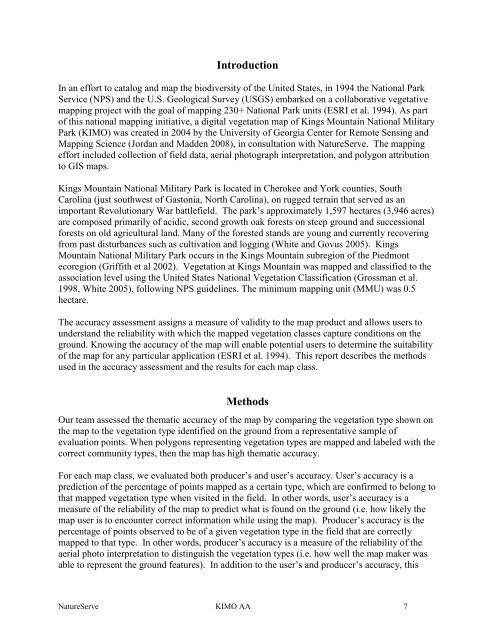Accuracy Assessment Report - the USGS
Accuracy Assessment Report - the USGS
Accuracy Assessment Report - the USGS
You also want an ePaper? Increase the reach of your titles
YUMPU automatically turns print PDFs into web optimized ePapers that Google loves.
IntroductionIn an effort to catalog and map <strong>the</strong> biodiversity of <strong>the</strong> United States, in 1994 <strong>the</strong> National ParkService (NPS) and <strong>the</strong> U.S. Geological Survey (<strong>USGS</strong>) embarked on a collaborative vegetativemapping project with <strong>the</strong> goal of mapping 230+ National Park units (ESRI et al. 1994). As partof this national mapping initiative, a digital vegetation map of Kings Mountain National MilitaryPark (KIMO) was created in 2004 by <strong>the</strong> University of Georgia Center for Remote Sensing andMapping Science (Jordan and Madden 2008), in consultation with NatureServe. The mappingeffort included collection of field data, aerial photograph interpretation, and polygon attributionto GIS maps.Kings Mountain National Military Park is located in Cherokee and York counties, SouthCarolina (just southwest of Gastonia, North Carolina), on rugged terrain that served as animportant Revolutionary War battlefield. The park’s approximately 1,597 hectares (3,946 acres)are composed primarily of acidic, second growth oak forests on steep ground and successionalforests on old agricultural land. Many of <strong>the</strong> forested stands are young and currently recoveringfrom past disturbances such as cultivation and logging (White and Govus 2005). KingsMountain National Military Park occurs in <strong>the</strong> Kings Mountain subregion of <strong>the</strong> Piedmontecoregion (Griffith et al 2002). Vegetation at Kings Mountain was mapped and classified to <strong>the</strong>association level using <strong>the</strong> United States National Vegetation Classification (Grossman et al.1998, White 2005), following NPS guidelines. The minimum mapping unit (MMU) was 0.5hectare.The accuracy assessment assigns a measure of validity to <strong>the</strong> map product and allows users tounderstand <strong>the</strong> reliability with which <strong>the</strong> mapped vegetation classes capture conditions on <strong>the</strong>ground. Knowing <strong>the</strong> accuracy of <strong>the</strong> map will enable potential users to determine <strong>the</strong> suitabilityof <strong>the</strong> map for any particular application (ESRI et al. 1994). This report describes <strong>the</strong> methodsused in <strong>the</strong> accuracy assessment and <strong>the</strong> results for each map class.MethodsOur team assessed <strong>the</strong> <strong>the</strong>matic accuracy of <strong>the</strong> map by comparing <strong>the</strong> vegetation type shown on<strong>the</strong> map to <strong>the</strong> vegetation type identified on <strong>the</strong> ground from a representative sample ofevaluation points. When polygons representing vegetation types are mapped and labeled with <strong>the</strong>correct community types, <strong>the</strong>n <strong>the</strong> map has high <strong>the</strong>matic accuracy.For each map class, we evaluated both producer’s and user’s accuracy. User’s accuracy is aprediction of <strong>the</strong> percentage of points mapped as a certain type, which are confirmed to belong tothat mapped vegetation type when visited in <strong>the</strong> field. In o<strong>the</strong>r words, user’s accuracy is ameasure of <strong>the</strong> reliability of <strong>the</strong> map to predict what is found on <strong>the</strong> ground (i.e. how likely <strong>the</strong>map user is to encounter correct information while using <strong>the</strong> map). Producer’s accuracy is <strong>the</strong>percentage of points observed to be of a given vegetation type in <strong>the</strong> field that are correctlymapped to that type. In o<strong>the</strong>r words, producer’s accuracy is a measure of <strong>the</strong> reliability of <strong>the</strong>aerial photo interpretation to distinguish <strong>the</strong> vegetation types (i.e. how well <strong>the</strong> map maker wasable to represent <strong>the</strong> ground features). In addition to <strong>the</strong> user’s and producer’s accuracy, thisNatureServe KIMO AA 7













